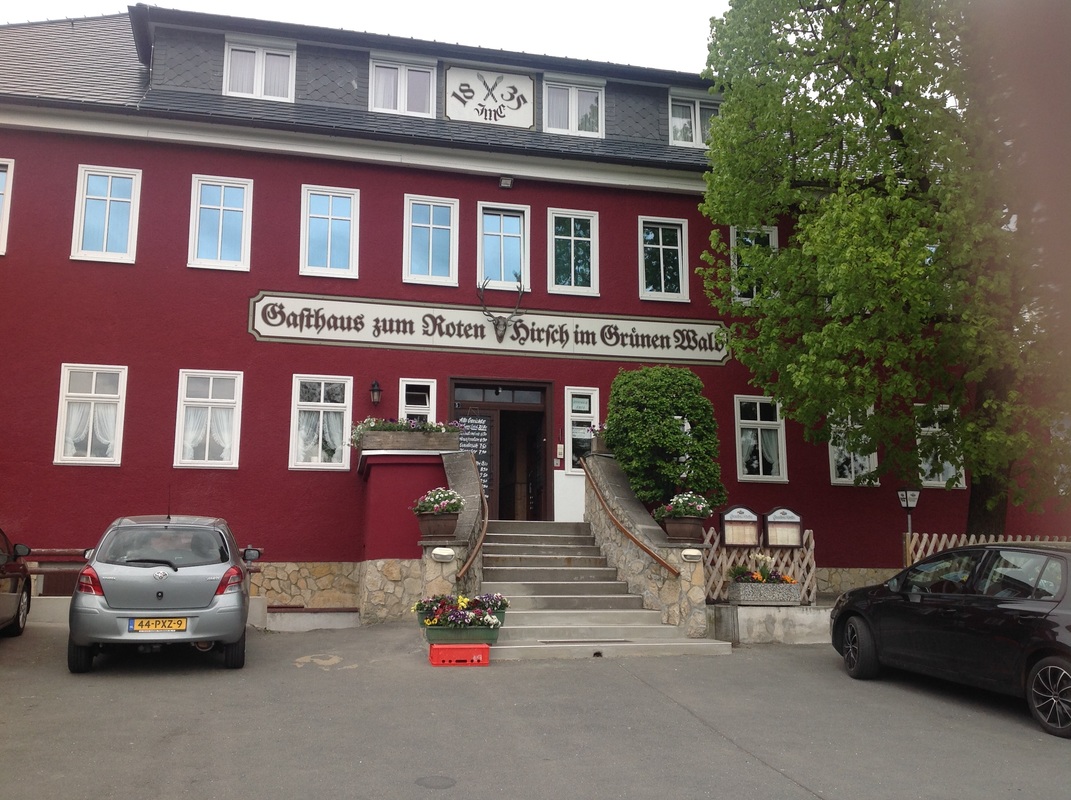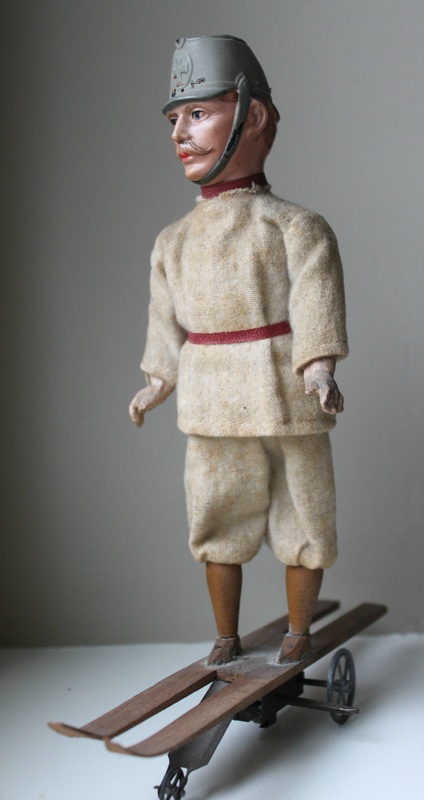|
Call me crazy, but the idea hit me that it would be fun to take people on tours of Germany, so I did it. Literally overnight. I decided a September tour date would give me enough time to plan . . . and, of course, we needed to be in (East) Germany the last Saturday of the month, because the huge Leipzig flea market is the last Saturday of every month, and so the decision was made. So the tour will be September 18th (leave from the US) through September 30th (return to US), with the official Germany dates being September 19th through the 29th. It was also a given that the tour would be of the Erzgebirge and Thuringian regions of former East Germany, as that's where I always go and know best. My friend in Germany will be my co-tour leader, so he and I just finished driving our route the past 10 days in Germany . . . all 1600 Kilometers . . . and we're excited about showing my American friends (East) Germany, with an emphasis on toys and Christmas, as this is what these regions are best known for. Of course, there has to be a visit to a castle along the way, and the very charming Schloss Scharfenstein in the Erzgebirge will work just fine. It even has an Erzgebirge/toy museum displaying beautiful antique Christmas in a gorgeous setting. The view from the top of the castle tower is breathtaking, as is the view on the long walk up to the entrance. We had to make sure to get proper accommodations, and we'll be spending the first four nights at the four star Hotel Wilder Mann in Annaberg-Buchholz/ Erzgebirge and the last six at the Hotel Anker in Saalfeld/Thuringia, the oldest Gasthaus in all of Germany dating to 1483. Obviously, food ranks high on the list of importance, so I came home all Schnitzled out tastetesting and eating three large meals each day, something I'm not used to. This Thuringian restaurant made the cut and will be on the tour. It met all the charm requirements . . . And the good food requirements . . . Seeing Lauscha, where Christmas ornaments originated and are still produced, is a must for the Christmas collectors, so I was thrilled to find a little "Familienbetrieb" (family run business) which will allow us to blow our own ornaments, something the large production facilities won't allow anymore because of safety requirements. I gave it a try myself, but working so close to the fire is frightening. Dresden will be our first stop Sunday morning after arriving in Germany. The city is wonderful. However, the next Sunday I've planned to explore the historic old city of Erfurt in Thuringia, which I'm certain will make a lasting impression on everyone. We'll begin at the Domplatz, which is the only place in Europe to have two churches of two denominations standing side by side -- Catholic and Evangelical. After a tour of the churches we will walk down a little street which suddenly takes you back in time hundreds and hundreds of years. Before long you are walking over the Krämerbrücke, which is the longest bridge of its kind in Europe, made up of half-timbered centuries-old houses and shops all built on a bridge . . . yet you would never even know there is water running beneath you. The image below is a photo of the Krämerbrücke from the back side of the structures which line the bridge. I can't wait until September to show everyone Germany Off The Beaten Path which I've come to know. There are a few more seats left on the bus. We've got a great group of people coming along, and if you're interested I'll be glad to send you the itinerary!
6 Comments
It's been a long time since a tramp art frame has gotten me this excited. It's a very busy piece . . . a lot going on here. The copper accent paint on top of the black makes it pop. The two four-leaf clovers on the top right and left are painted a dark green lightly tipped in copper. I was told it held a picture commemorating an end to a conflict in South Africa with some men sitting around a table (which I stupidly threw away), so a lot of the decorative elements remind me of spears and bullets, but I may be wrong. At any rate, the old photo has been replaced by one of my Oma (left) holding a freshly picked cucumber in a garden with her friends in West Amana, Iowa. It fits the frame like a glove! The year 1914 is carved in the center pediment, and the photo I replaced it with is very close to that year as well. The beautiful carved clasped hands at the bottom of the frame are also a nice fit for my photo, showing the friendship of these women which lasted for the life of my Oma.
I've been looking for over a year, and finally found the perfect shelf for my German wooley sheep. I have a thing for curly maple and tiger maple, and was thrilled that I finally found a reasonably priced curly maple piece, ca. 1850. Also found room for a few German Santa candy containers; the red-coated one is a combination container and nodder.
Here it is, Christmas Day. Santa with his team of eight reindeer, all nine pieces candy containers, is usually displayed on my dining room table at this time of year. The containers would have been filled with candy for the children. Fine workmanship and painting of the German papier-mache reindeer makes this set very special indeed.
I wish everyone the merriest of Christmases! Santa's elves are hard at work today, being Christmas Eve. Here is a rare grouping of German papier-mache elves (Wichtelmaenner), each one a candy container. One holds a feather tree sprig, another has on his work apron holding a shovel, and the one in the foreground is resting on a red wooden sleigh. Great detail in the faces and clothing of the molds used to create the candy constainers, as well as brightly colored clothing with hand painting. Ca. 1900.
It's getting close to Christmas and about time for Santa to make an appearance under the tree. Here he sits atop a German wooly sheep, but a very special one on rockers. I've only seen one other example, although I'm sure there are more out there. A real collecting craze has begun in the last few years over these fleece-covered sheep. Christmas and primitive collectors alike absolutely love them!
Early Erzgebirge ferris wheel, ca. 1900. Simple colored dots decoration is all you need to turn this into a great piece of folk art! The hand crank turns the blades, and the wooden buckets full of colorful riders swing gently. A fun child's toy, to be sure.
Children no doubt spent hours playing with this Erzgebirge zoo, circa 1850s.The buildings (cages) are constructed out of thin wood and hand painted. Again, beautiful pieces of folk art. There are little metal hooks at the front of the cages on which the wild animals were to have been tied. The elephant would have also had a thin chain around his neck. There would have been several more buildings, wild animals, trees and male figures to tend to the animals originally as a part of this set. I feel very lucky to have found these pieces as, again, these play sets received a lot of hard play and, thus, are extremely hard to find today.
This German windup toy shows an unusual subject matter, a man on wooden skis wearing a helmet embossed with the Iron Cross, dating the piece to about 1915 during World War I. The celluloid hat and head is all one piece on a body of wood with papier-mache hands and wooden legs and feet. No doubt a gift to a little boy at the height of the war.
Thuringian German soldiers skittles set, ca. 1890s, in amazing condition, considering the goal is to knock these men made of papier-mache over with a ball. What a fun game for a little boy!
|
Archives
May 2015
Susan's PageWelcome to Living Tastefully’s “Antique of the Week” page. Our love of antiques is reflected in every aspect of our everyday lives. We are passionate about collecting and also love functional antiques that can actually be used and not only admired. Hopefully we can inspire you to incorporate antiques in your home and your life to add charm and beauty to your surroundings.
All
Links
|


















 RSS Feed
RSS Feed